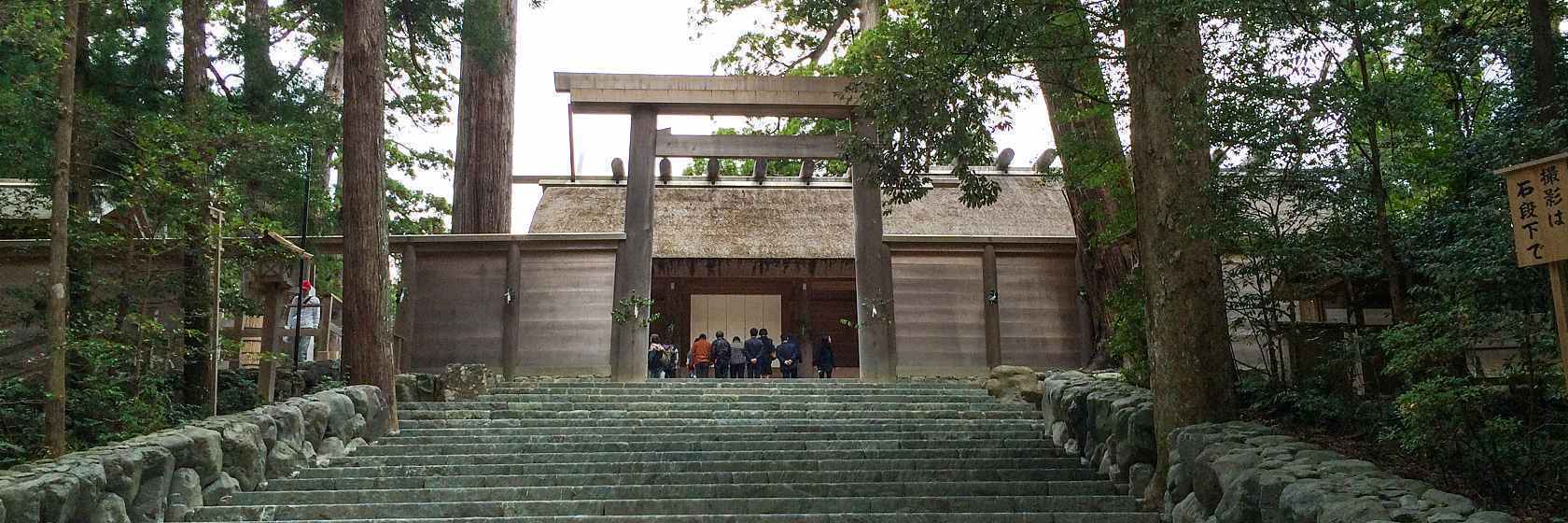Shinto shrines (神社, jinja) are places of worship and the dwellings of the kami, the Shinto "gods". Sacred objects of worship that represent the kami are stored in the innermost chamber of the shrine where they cannot usually be seen by anybody. In some cases, a mountain, waterfall or rock behind the shrine building can be the object of worship.
People visit shrines in order to pay respect to the kami or to pray for good fortune. Shrines are also visited during special events such as New Year, Setsubun, Shichigosan and other festivals. New born babies are traditionally brought to a shrine a few weeks after birth, and many couples hold their wedding ceremonies there.
The following structures and objects can be typically found at a shrine:
There can be a variety of additional buildings such as the priest's house and office, a storehouse for festival palanquins (mikoshi) and other auxiliary buildings. Cemeteries, on the other hand, are almost never found at shrines, because death is considered a cause of impurity in Shinto, and in Japan is dealt with mostly by Buddhism.
The architecture and features of Shinto shrines and Buddhist temples have melted together over the centuries. There are several construction styles, most of which show (Buddhist) influences from the Asian mainland. Only a few of today's shrines are considered to be built in a purely Japanese style. Among them are Shinto's most important shrines, the Ise Shrines.
There are tens of thousands of shrines across Japan, some of which can be categorized into a few major groups of shrines. Some of these groups are:
- Imperial shrines
These are the shrines which were directly funded and administered by the government during the era of State Shinto. They include many of Shinto's most important shrines such as the Ise Shrines, Izumo Shrine and Atsuta Shrine, and a number of shrines newly built during the Meiji Period, such as Tokyo's Meiji Shrine and Kyoto's Heian Shrine. Imperial shrines can be recognized by the imperial family's chrysanthemum crest and by the fact that they are often called "jingu" rather than "jinja". - Inari shrines
Inari shrines are dedicated to Inari, the kami of rice. They can be recognized by fox statues, as the fox is considered the messenger of Inari. There are thousands of Inari shrines across Japan, among which Kyoto's Fushimi Inari Shrine is most famous. - Hachiman shrines
Hachiman shrines are dedicated to Hachiman, the kami of war, which used to be particularly popular among the leading military clans of the past. Of Japan's thousands of Hachiman shrines, the most famous is probably Kamakura's Tsurugaoka Hachimangu, while their head shrine is Usa Shrine on Kyushu. - Tenjin shrines
Tenjin shrines are dedicated to the kami of Sugawara Michizane, a Heian Period scholar and politician. They are particularly popular among students preparing for entrance exams. Tenjin shrines can be recognized by ox statues and plum trees, Michizane's favorite trees. The most famous Tenjin shrine is Dazaifu Tenmangu near Fukuoka. - Sengen shrines
Sengen shrines are dedicated to Princess Konohanasakuya, the Shinto deity of Mount Fuji. More than one thousand Sengen shrines exist across Japan, with the head shrines standing at the foot and the summit of Mount Fuji itself. - Shrines dedicated to the founders of powerful clans
Some powerful clans in Japanese history established and dedicated shrines to the their clans' founders. The most famous example are the several dozens of Toshogu shrines dedicated to Tokugawa Ieyasu, including the famous Toshogu Shrine at Nikko. Another example is Kanazawa's Oyama Shrine which is dedicated to Maeda Toshiie, the founder of the powerful, local Maeda clan. - Local shrines
Many shrines are dedicated to local kami without association to other shrines.
Best Shrines in Japan
Questions? Ask in our forum.




















